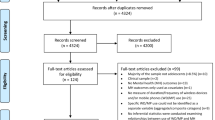Abstract
Objectives
Previous studies on the health of migrants in Germany focus either on the health of children or on that of adults of ethnic minorities in comparison to the German population. In our study the health status of preschool-aged children and their parents among Germans and ethnic minorities was studied and interlinked.
Methods
A cross-sectional study in 2001-2002 in Germany linked medical data on children at school entry and survey data on their parents to assess medical diagnoses, health, and well-being.
Results
The sample contains data of 525 records of both children and their parents (258 migrants, 267 Germans). The highest prevalence rates are found for diseases of the motor system, coordination, vision and hearing, behavioral disorders and speech and language impairment. Prevalence rates of medically diagnosed diseases among the children differ between migrants and Germans, as well as between boys and girls. Our data indicate that the specific ethnic background may play an important role for behavioral disorders and speech and language impairment. The parental self-reported health status shows a generally good health status for Germans and migrants, although Germans reported significantly more physical health problems. A combination of health data of children and parents revealed a higher prevalence of asthma, allergy and respiratory diseases among children of parents with partially impaired health compared to those of healthy parents.
Conclusions
Since social factors and ethnic background partly explain differences in the health status of migrants and Germans, a combined health assessment of children and parents might be a useful additional tool to estimate the health status of ethnic minorities. Further development of health questionnaires and health indices applicable to children and their parents would be required to improve the methodological approach for such studies.
Similar content being viewed by others
References
Abraido-Lanza AF, Dohrenwend BP, Ng-Mak DS, Turner JB (1999) The Latino mortality paradox: a test of the “salmon bias” and healthy migrant hypotheses. Am J Public Health. 89:1543–1548
Almeida-Filho N, Lessa I, Magalh es L, Ara jo MJ, Aquino E, Kawachi I, James SA (2004) Alcohol drinking patterns by gender, ethnicity, and social class in Bahia, Brazil. Rev Saude Publica 38:45–54
Arendt G, van Giesen HJ (2003) HIV-1-positive female migrants in North Rhine-Westphalia—relevant, but unfocused problem? Eur J Med Res 304:137–141
Bhugra D (2004) Migration and mental health. Acta Psychiatr Scand 109:243–258
Fichter MM, Xepapadakos F, Quadflieg N, Georgopoulou E, Fthenakis WE (2004) A comparative study of psychopathology in Greek adolescents in Germany and in Greece in 1980 and 1998—18 years apart. Eur Arch Psychiatry Clin Neurosci 254:27–35
Grieger D, Gardemann J (2003) Objectives and activities of the German Federal Working group on migration and public health. Gesundheitswesen 65:704–708
Grulich AE, Swerdlow AJ, Head J, Marmot MG (1992) Cancer mortality in African and Caribbean migrants to England and Wales. Br J Cancer 66:905–911
Kuhnisch J, Senkel H, Heinrich-Weltzen R (2003) Comparative study on the dental health of German and immigrants 8- to 10-years old in the Westphalian Ennepe-Ruhr district. Gesundheitswesen 65:96–101
Razum O, Zeeb H (1998) Epidemiologic studies among foreign immigrants in Germany—rationale and obstacles. Gesundheitswesen. 60:283–286
Schäfer P, Scholer H, Roos J, Grun-Nolz P, Engler-Thummel H (2003) Initial examination for school attendance in Mannheim: language development at initial school entry level. Gesundheitswesen. 65:676–682
Schenk L (2002) Migrant specific participation barriers and accessibility in The Child and Adolescent Health Survey. Gesundheitswesen. 64[Suppl 1]:59–68
Schirm H (1989) Untersuchungen und Untersuchungsmodelle zur Feststellung der Einschulungsfähigkeit. Soz Päd 11:7–11
Schmacke N (2002) Migration and health: is segregation inevitable? Gesundheitswesen. 64:554–559
SPSS for Windows, Release 11.01. SPSS Inc. Headquarters, 233 S. Wacker Drive, 11th floor, Chicago, Illinois 60606
Weilandt A, Huismann A, Joksimovic L, Klaes L, Van den Toorn S, Winkler J (2000) Health of Immigrants to North Rhine-Westphalia. Ministry for Women, Youth, Family and Health in North Rhine-Westphalia. Duesseldorf. Health Reports NRW (in German)
Zeeb H, Razum O, Blettner M, Stegmaier C (2002) Transition in cancer patterns among Turks residing in Germany. Eur J Cancer 38:705–711
Zeeb H, Baune BT, Vollmer W, Cremer D, Krämer A (2004) Health situation of and health service provided for adult migrants—a survey conducted during school admittance examinations. Gesundheitswesen 66:76–84
Author information
Authors and Affiliations
Corresponding author
Rights and permissions
About this article
Cite this article
Baune, B.T., Will, B., Zeeb, H. et al. Comparative health assessment among migrants and Germans: combined results of a school health examination and a health survey among parents. J Public Health 13, 153–159 (2005). https://doi.org/10.1007/s10389-005-0099-9
Received:
Accepted:
Published:
Issue Date:
DOI: https://doi.org/10.1007/s10389-005-0099-9




